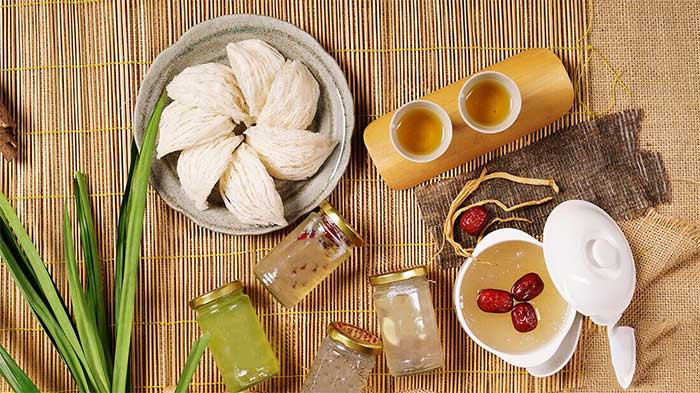Bird’s nest or edible bird’s nest is rich in nutrients and beneficial for health. This superfood enhances bone and brain health, improves digestion, and boosts the immune system. Therefore, bird’s nest is a popular gift during the Lunar New Year celebrations.
Typically, consumers find it challenging to differentiate between real and fake bird’s nests through observation alone. This can lead to purchasing counterfeit or low-quality products. Fake bird’s nests may be made from agar powder, starch, egg whites, rice vermicelli, and other substances of unclear origin. Consuming fake bird’s nests not only provides no benefits to the body but can also negatively affect overall health, potentially causing unwanted side effects.

Fake bird’s nests can be made from agar powder, starch, egg whites…
Some criteria to help distinguish between real and fake bird’s nests include:
Color and texture: There are three types of real bird’s nests on the market: white nest (opaque white), pink nest (light pink or may turn yellowish or orange), and red nest (distinct red color). Fake nests are bright white, and when held up to light, they may appear transparent. Additionally, real bird’s nests will show easily recognizable intertwined strands.
Taste: A common method to test for authenticity is by tasting. Take a small strand of the nest and taste it; if it is not overly sweet and has a texture similar to egg whites, it is real. If it tastes sweet, you may have accidentally purchased a low-quality nest, as these are often mixed with sugar for binding.
Elasticity: You can check the authenticity of the bird’s nest by gently squeezing it. If it feels brittle and breaks easily, it is a sign of a real nest. Fake nests often mixed with other substances tend to be softer and more elastic.
Soaking in water is a simple and highly accurate method to determine if a bird’s nest is real or fake. When soaked in water, real bird’s nests will gradually expand, maintaining their original color and emitting a characteristic fishy smell similar to egg whites. If the nest dissolves in water and changes color or emits an unusual odor from additives, it is fake and of low quality.
Bird’s nest is a food that helps boost the body’s resistance. However, incorrect dosage or methods of consumption can have adverse effects. For healthy individuals, consuming bird’s nests regularly may not significantly impact health. However, elderly individuals, young children, and the ill consuming excessive amounts can negatively affect their digestive system and overall health. The reason is that bird’s nests contain 45-55% protein, and excessive protein intake is not beneficial for the body.
Therefore, the elderly and sick should consume bird’s nests 2-3 times a week, with each serving being around 3 grams. Additionally, experts recommend long-term and regular consumption of bird’s nests.
Children under one year old should not consume bird’s nests in any form as their digestive systems are not fully developed. They cannot absorb all the nutrients from the nests.
Children aged 1-3 years can start to consume bird’s nests or drink bird’s nest soup. However, since bird’s nests are nutrient-dense and high in protein, parents should pay attention to the portion sizes to avoid overloading their child with nutrients in one sitting, which is not good for their health. At this stage, parents can introduce bird’s nests to their children at a portion of about 1-2 grams, three times a week.
Children aged 3-10 years are in a critical stage of brain and physical development, making it the most suitable age for bird’s nest consumption. Bird’s nests provide ample energy and nutrients for children, so they can consume 2-3 grams each time, three times a week.


















































